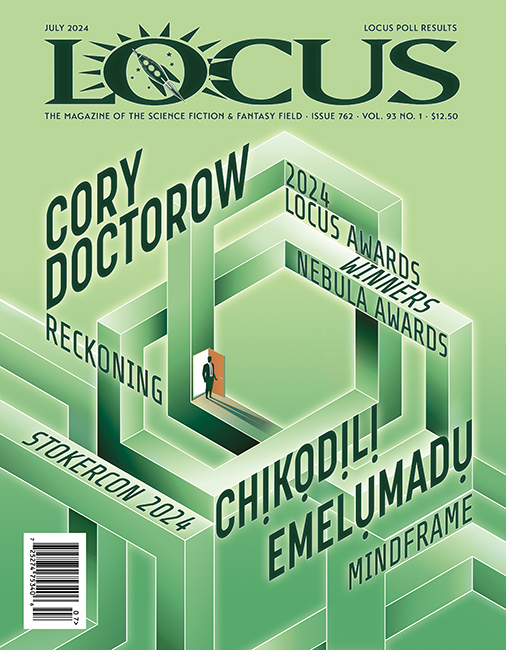-
Gene Szafran’s cover for 1971 edition
3.25/5 (Above Average)
A preliminary note: I’m something of a Robert Silverberg completionist, especially work from his glory years of 1967-1975. I’ve reviewed forty-seven of Silverberg’s short stories and thirteen of his novels–I’ve also read but never reviewed A Time of Changes (1971), The Masks of Time (1968), Tower of Glass (1970), and the stories in Capricorn Games (1976).
While a middling Silverberg novel at best, Those Who Watch (1967) almost succeeds as a revisionist take on UFO panic. The aliens do not seek to experiment on, exterminate, or manipulate humans. Instead, this is a book about the lost and lonely, and how their love and care for the injured interstellar visitors that appear on their doorsteps transform their lives. It’s a problematic work that simultaneously pulses with kindness.
The General Shape of Things Across the New Mexico Sky
The year is 1982. Two metamorphic alien races, engaged in a seemingly perpetual galactic cold war, watch Earth. Each worries for the day when humanity reaches the stars. A Dirnan watcher spaceship crashes in the New Mexico desert separating and stranding its three crew, members of a sexual group (male, male, female). Each injured survivor is found by a kind person in need. All three humans see beyond the humanoid alien exteriors yet still provide assistance and protection.
Charley Estancia, an eleven-year-old Native American, does not feel at home on his reservation. His family “thought [him] to be a little crazy in the head, a skinny boy full of dreams and white man’s ideas” (6). He wants to attend an interracial high school in Albuquerque and become an astronaut. In one of Silverberg’s many problematic moments, Charley grows frustrated with his own people–“crazy, all of them. Crazy with fear, crazy with religion” (6). He sees tribal practice as entirely pandering to the desires of white tourists rather than meaningful belief and tradition. One day discovers Mirtin, the eldest of the Dirnan sexual group, horrifically injured. He brings Mirtin tortillas and ascertains the alien providence of his visitor. They enjoy each others company. Mirtin represents the vast world that exists beyond his pueblo. And Mirtin sees the opportunity to encourage a precocious young mind.
Colonel Tom Falkner struggles with his recent divorce and a job he adamantly does not believe in. Ever since his earliest memories reading UFO stories and science fiction, Falkner wanted to be an astronaut. A night in 1970 looms in his memory, the beginning of the end, in which a fellow trainee drunkenly told him that his lack of “a couple of clean-cut kids waiting for him to come home” spoils the “TV part” of being an American hero (14). Six months later, Falkner’s cut after a routine physical for an ailment of his inner ear that demonstrated, as of yet, “no overt tendencies” (14). The Air Force lined him up with a soul-destroying job in the Atmospheric Objects Survey, the lead man investigating claims of UFO contact in Arizona, New Mexico, Utah, and Colorado (15). He comes across the injured Glair, the female member of the Dirnan sexual group, and he decides not to report his discovery to his superiors. She seems to be a plastic recreation of his dream woman. Cue Silverberg’s breast fetish. Glair loves both of her partners and initially sees her sexual relationship with Falkner more as a means of survival. But due to his kindness and deep pain, she finds room “to love someone else, too” (88). Their shared loved helps guide him out of his haze.
Kathryn walls herself and her child up in a new suburban house, replete with mechanical childcare device, at the edge of the desert. She mourns the death of her husband. Numb from the pain, she stumbles upon Vorneen (the male heartthrob of the alien group). She impulsively decides to not turn in the strangely alien man. She wonders if her husband, who died in a crash in Syria in an anti-Communist “peace” intervention, waited for assistance that never came. As she nurses Vorneen back to health, she attempts to understand whether the local Contact Cult tells the truth about stories of humanity’s interaction with aliens. Kathryn concludes the Contact Cult is a shame and decides to keep the secret of her alien patient to herself. Silverberg includes a sustained attack on an organized religion based on alien contact which, I assume, doubles as an attack on Scientology. He ridicules its moneymaking aim: “Kathyrn was startled [at the charge for religious materials]. Proselytizers didn’t usually dive for profits so early in the conversion process” (80). And also points out the crafty intersection of “ancient ritual and modern scientific gadgetry” that deludes its followers (78). The self-presentation of Contact Cult’s founder Frederic Storm elicits parallels to fascist imagery (79). Vorneen’s love drags Kathryn out of her numb pain. And like Glair, Vorneen feels true connection to his human caretaker.
UFO Panic as Rumination on Loss and Loneliness
Those Who Watch overtly engages with the growing 60s obsession with UFO paranoia.1 Silverberg suggests that Americans project their fears into the skies in periods of great stress–“just after the Second World War, in the new atomic tensions of the U.S.-Russian rivalry” and after Kennedy’s assassination (27). In the years before Silverberg wrote his novel, the case of Barney and Betty Hilly garnered substantial press and a best-selling book The Interrupted Journey (1966).2 The couple claimed they were abducted by humanoid extraterrestrials in spaceship with flashing red lights in rural New Hampshire. At first glance, Silverberg feeds into the narrative of gross government coverup and sinister galactic plans, the Earth is indeed watched by two alien factions.
The galactic details remain in the background. Silverberg avoids the standard UFO plot points. Instead, the focus remains on the peaceful and kind interaction between the three humans and the alien sexual group they encounter. This is a quiet novel distant that reworks the moment of paranoia that spawned it. Despite Silverberg’s frustrating tendencies (a fixation on breasts and a condescending treatment of Native American ritual), Those Who Watch reads as a sex-positive novel–dare I say “free love”–with space for non-heteronormative relationships (although, only between aliens).
Somewhat recommended for Silverberg fans.
-

Tim White’s cover for the 1977 edition
Notes
For book reviews consult the INDEX
For cover art posts consult the INDEX
For TV and film reviews consult the INDEX







